Effect of Carbon Content in Wheat Straw Biochar on N2O and CO2 Emissions and Pakchoi Productivity Under Different Soil Moisture Conditions
Abstract
1. Introduction
2. Materials and Methods
2.1. Description of Study Side and Experimental Setup
2.2. Soil Sampling and Analyses
2.3. N2O and CO2 Measurement and Analyses
2.4. Agronomic Practices and Growth Indicator Measurements
2.5. Statistical Analysis
3. Results
3.1. Wetting Pattern Dynamics
3.2. Nitrous Oxide (N2O) Flux
3.3. Carbon Dioxide (CO2) Flux
3.4. Cumulative N2O and CO2 Emissions
3.5. Growth Parameters and Yield Traits
3.5.1. Plant Height (PH), Leaf Area Index (LAI), Leaves Number (LN), and Maximum Root Length (MRL)
3.5.2. Aboveground Biomass (AGB), Root Dry Biomass (RDB), Aboveground Weight (AGW), and Root Fresh Weight (RFW)
4. Discussion
4.1. The Effect of Different Biochar C Contents and Irrigation Depths on Soil Moisture Dynamics
4.2. N2O Emissions Response to Irrigation Depths and Different C Content Biochar
4.3. CO2 Emission Response to Irrigation Depths and Different Biochar C Content
4.4. Influence of Irrigation Depths and Different Biochar C Content on Plant Growth and Yield
5. Conclusions
Author Contributions
Funding
Institutional Review Board Statement
Informed Consent Statement
Data Availability Statement
Acknowledgments
Conflicts of Interest
References
- Lehmann, J.; Gaunt, J.; Rondon, M. Bio-Char Sequestration in Terrestrial Ecosystems—A Review. Mitig. Adapt. Strateg. Glob. Chang. 2006, 11, 403–427. [Google Scholar] [CrossRef]
- Zhang, Y.; Wang, J.; Feng, Y. The Effects of Biochar Addition on Soil Physicochemical Properties: A Review. Catena 2021, 202, 105284. [Google Scholar] [CrossRef]
- Han, J.; Zhang, A.; Kang, Y.; Han, J.; Yang, B.; Hussain, Q.; Wang, X.; Zhang, M.; Khan, M.A. Biochar Promotes Soil Organic Carbon Sequestration and Reduces Net Global Warming Potential in Apple Orchard: A Two-Year Study in the Loess Plateau of China. Sci. Total Environ. 2022, 803, 150035. [Google Scholar] [CrossRef]
- Cabeza, I.; Waterhouse, T.; Sohi, S.; Rooke, J.A. Effect of Biochar Produced from Different Biomass Sources and at Different Process Temperatures on Methane Production and Ammonia Concentrations in Vitro. Anim. Feed Sci. Technol. 2018, 237, 1–7. [Google Scholar] [CrossRef]
- Liang, B.; Lehmann, J.; Sohi, S.P.; Thies, J.E.; O’Neill, B.; Trujillo, L.; Gaunt, J.; Solomon, D.; Grossman, J.; Neves, E.G.; et al. Black Carbon Affects the Cycling of Non-Black Carbon in Soil. Org. Geochem. 2010, 41, 206–213. [Google Scholar] [CrossRef]
- Tomczyk, A.; Sokołowska, Z.; Boguta, P. Biochar Physicochemical Properties: Pyrolysis Temperature and Feedstock Kind Effects. Rev. Environ. Sci. Biotechnol. 2020, 19, 191–215. [Google Scholar] [CrossRef]
- Xiao, X.; Chen, B.; Chen, Z.; Zhu, L.; Schnoor, J.L. Insight into Multiple and Multilevel Structures of Biochars and Their Potential Environmental Applications: A Critical Review. Environ. Sci. Technol. 2018, 52, 5027–5047. [Google Scholar] [CrossRef] [PubMed]
- Kamali, M.; Sweygers, N.; Al-Salem, S.; Appels, L.; Aminabhavi, T.M.; Dewil, R. Biochar for Soil Applications-Sustainability Aspects, Challenges and Future Prospects. Chem. Eng. J. 2022, 428, 131189. [Google Scholar] [CrossRef]
- Liu, X.; Zhang, J.; Wang, Q.; Shaghaleh, H.; Chang, T.; Hamoud, Y.A. Modification of Soil Physical Properties by Maize Straw Biochar and Earthworm Manure to Enhance Hydraulic Characteristics under Greenhouse Condition. Sustainability 2022, 14, 13590. [Google Scholar] [CrossRef]
- Jovanovic, Z.; Stikic, R. Partial Root-Zone Drying Technique: From Water Saving to the Improvement of a Fruit Quality. Front. Sustain. Food Syst. 2018, 1, 3. [Google Scholar] [CrossRef]
- Hamoud, Y.A.; Guo, X.; Wang, Z.; Chen, S.; Rasool, G. Effects of Irrigation Water Regime, Soil Clay Content and Their Combination on Growth, Yield, and Water Use Efficiency of Rice Grown in South China. Int. J. Agric. Biol. Eng. 2018, 11, 144–155. [Google Scholar] [CrossRef]
- Carrijo, D.R.; Akbar, N.; Reis, A.F.B.; Li, C.; Gaudin, A.C.M.; Parikh, S.J.; Green, P.G.; Linquist, B.A. Impacts of Variable Soil Drying in Alternate Wetting and Drying Rice Systems on Yields, Grain Arsenic Concentration and Soil Moisture Dynamics. F Crop. Res. 2018, 222, 101–110. [Google Scholar] [CrossRef]
- Fu, B.; Li, Z.; Gao, X.; Wu, L.; Lan, J.; Peng, W. Effects of Subsurface Drip Irrigation on Alfalfa (Medicago Sativa L.) Growth and Soil Microbial Community Structures in Arid and Semi-Arid Areas of Northern China. Appl. Soil Ecol. 2021, 159, 103859. [Google Scholar] [CrossRef]
- Martínez-Gimeno, M.A.; Bonet, L.; Provenzano, G.; Badal, E.; Intrigliolo, D.S.; Ballester, C. Assessment of Yield and Water Productivity of Clementine Trees under Surface and Subsurface Drip Irrigation. Agric. Water Manag. 2018, 206, 209–216. [Google Scholar] [CrossRef]
- Hamad, A.A.A.; Wei, Q.; Xu, J.; Hamoud, Y.A.; He, M.; Shaghaleh, H.; Wei’, Q.; Li, X.; Qi, Z. Managing Fertigation Frequency and Level to Mitigate N2O and CO2 Emissions and NH3 Volatilization from Subsurface Drip-Fertigated Field in a Greenhouse. Agronomy 2022, 12, 1414. [Google Scholar] [CrossRef]
- Arif, M.; Ilyas, M.; Riaz, M.; Ali, K.; Shah, K.; Ul Haq, I.; Fahad, S. Biochar Improves Phosphorus Use Efficiency of Organic-Inorganic Fertilizers, Maize-Wheat Productivity and Soil Quality in a Low Fertility Alkaline Soil. F. Crop. Res. 2017, 214, 25–37. [Google Scholar] [CrossRef]
- Güereña, D.; Lehmann, J.; Hanley, K.; Enders, A.; Hyland, C.; Riha, S. Nitrogen Dynamics Following Field Application of Biochar in a Temperate North American Maize-Based Production System. Plant Soil 2013, 365, 239–254. [Google Scholar] [CrossRef]
- Liu, Z.; Niu, W.; Chu, H.; Zhou, T.; Niu, Z. Effect of the Carbonization Temperature on the Properties of Biochar Produced from the Pyrolysis of Crop Residues. BioResources 2018, 13, 3429–3446. [Google Scholar] [CrossRef]
- Hui, D.; Hui, D. Effects of Biochar Application on Soil Properties, Plant Biomass Production, and Soil Greenhouse Gas Emissions: A Mini-Review. Agric. Sci. 2021, 12, 213–236. [Google Scholar] [CrossRef]
- Yang, X.Y.; Chang, K.H.; Kim, Y.J.; Zhang, J.; Yoo, G. Effects of Different Biochar Amendments on Carbon Loss and Leachate Characterization from an Agricultural Soil. Chemosphere 2019, 226, 625–635. [Google Scholar] [CrossRef]
- Ali, E.F.; Al-Yasi, H.M.; Kheir, A.M.S.; Eissa, M.A. Effect of Biochar on CO2 Sequestration and Productivity of Pearl Millet Plants Grown in Saline Sodic Soils. J. Soil Sci. Plant Nutr. 2021, 21, 897–907. [Google Scholar] [CrossRef]
- Zimmerman, A.R.; Gao, B.; Ahn, M.Y. Positive and Negative Carbon Mineralization Priming Effects among a Variety of Biochar-Amended Soils. Soil Biol. Biochem. 2011, 43, 1169–1179. [Google Scholar] [CrossRef]
- Keiluweit, M.; Nico, P.S.; Johnson, M.; Kleber, M. Dynamic Molecular Structure of Plant Biomass-Derived Black Carbon (Biochar). Environ. Sci. Technol. 2010, 44, 1247–1253. [Google Scholar] [CrossRef] [PubMed]
- Bruun, E.W.; Hauggaard-Nielsen, H.; Ibrahim, N.; Egsgaard, H.; Ambus, P.; Jensen, P.A.; Dam-Johansen, K. Influence of Fast Pyrolysis Temperature on Biochar Labile Fraction and Short-Term Carbon Loss in a Loamy Soil. Biomass Bioenergy 2011, 35, 1182–1189. [Google Scholar] [CrossRef]
- Zhang, J.; Li, H.; Wang, Y.; Deng, J.; Wang, L. Multiple-Year Nitrous Oxide Emissions from a Greenhouse Vegetable Field in China: Effects of Nitrogen Management. Sci. Total Environ. 2018, 616–617, 1139–1148. [Google Scholar] [CrossRef]
- Qi, Y.; Wu, Z.; Zhou, R.; Hou, X.; Yu, L.; Cao, Y.; Jiang, F. Nitrogen Reduction with Bio-Organic Fertilizer Altered Soil Microorganisms, Improved Yield and Quality of Non-Heading Chinese Cabbage (Brassica Campestris Ssp. Chinensis Makino). Agronomy 2022, 12, 1437. [Google Scholar] [CrossRef]
- Wei, Q.; Xu, J.; Li, Y.; Liao, L.; Liu, B.; Jin, G.; Hameed, F. Reducing Surface Wetting Proportion of Soils Irrigated by Subsurface Drip Irrigation Can Mitigate Soil N2O Emission. Int. J. Environ. Res. Public Health 2018, 15, 2747. [Google Scholar] [CrossRef]
- Ning, D.; Qin, A.; Duan, A.; Xiao, J.; Zhang, J.; Liu, Z.; Liu, Z.; Zhao, B.; Liu, Z. Deficit Irrigation Combined with Reduced N-Fertilizer Rate Can Mitigate the High Nitrous Oxide Emissions from Chinese Drip-Fertigated Maize Field. Glob. Ecol. Conserv. 2019, 20, e00803. [Google Scholar] [CrossRef]
- Wei, Q.; Li, X.; Xu, J.; Dai, H.; Li, B.; Xu, J.; Wei, Q.; Wang, K. Responses of Soil N2O and CO2 Emissions and Their Global Warming Potentials to Irrigation Water Salinity. Atmosphere 2022, 13, 1777. [Google Scholar] [CrossRef]
- Searle, P.L. The Berthelot or Indophenol Reaction and Its Use in the Analytical Chemistry of Nitrogen. A Review. Analyst 1984, 109, 549–568. [Google Scholar] [CrossRef]
- Hou, H.; Chen, H.; Cai, H.; Yang, F.; Li, D.; Wang, F. CO2 and N2O Emissions from Lou Soils of Greenhouse Tomato Fields under Aerated Irrigation. Atmos. Environ. 2016, 132, 69–76. [Google Scholar] [CrossRef]
- Hamad, A.A.A.; Wei, Q.; Wan, L.; Xu, J.; Hamoud, Y.A.; Li, Y.; Shaghaleh, H. Subsurface Drip Irrigation with Emitters Placed at Suitable Depth Can Mitigate N2O Emissions and Enhance Chinese Cabbage Yield under Greenhouse Cultivation. Agronomy 2022, 12, 745. [Google Scholar] [CrossRef]
- Kuang, W.; Gao, X.; Gui, D.; Tenuta, M.; Flaten, D.N.; Yin, M.; Zeng, F. Effects of Fertilizer and Irrigation Management on Nitrous Oxide Emission from Cotton Fields in an Extremely Arid Region of Northwestern China. F. Crop. Res. 2018, 229, 17–26. [Google Scholar] [CrossRef]
- Liu, G.; Li, Y.; Alva, A.K. High Water Regime Can Reduce Ammonia Volatilization from Soils under Potato Production. Commun. Soil Sci. Plant Anal. 2007, 38, 1203–1220. [Google Scholar] [CrossRef]
- Weldon, S.; Rasse, D.P.; Budai, A.; Tomic, O.; Dörsch, P. The Effect of a Biochar Temperature Series on Denitrification: Which Biochar Properties Matter? Soil Biol. Biochem. 2019, 135, 173–183. [Google Scholar] [CrossRef]
- Yang, W.; Feng, G.; Miles, D.; Gao, L.; Jia, Y.; Li, C.; Qu, Z. Impact of Biochar on Greenhouse Gas Emissions and Soil Carbon Sequestration in Corn Grown under Drip Irrigation with Mulching. Sci. Total Environ. 2020, 729, 138752. [Google Scholar] [CrossRef]
- Karer, J.; Wimmer, B.; Zehetner, F.; Kloss, S.; Soja, G. Biochar Application to Temperate Soils: Effects on Nutrient Uptake and Crop Yield under Field Conditions. Agric. Food Sci. 2013, 22, 390–403. [Google Scholar] [CrossRef]
- Rushimisha, I.E.; Li, X.; Han, T.; Chen, X.; Abdoul Magid, A.S.I.; Sun, Y.; Li, Y. Application of Biochar on Soil Bioelectrochemical Remediation: Behind Roles, Progress, and Potential. Crit. Rev. Biotechnol. 2022, 1–9. [Google Scholar] [CrossRef]
- Zhao, Y.; Li, X.; Li, Y.; Bao, H.; Xing, J.; Zhu, Y.; Nan, J.; Xu, G. Biochar Acts as an Emerging Soil Amendment and Its Potential Ecological Risks: A Review. Energies 2023, 16, 410. [Google Scholar] [CrossRef]
- Hussain, R.; Ravi, K.; Garg, A. Influence of Biochar on the Soil Water Retention Characteristics (SWRC): Potential Application in Geotechnical Engineering Structures. Soil Tillage Res. 2020, 204, 104713. [Google Scholar] [CrossRef]
- Sun, B.F.; Zhao, H.; Lü, Y.Z.; Lu, F.; Wang, X.K. The Effects of Nitrogen Fertilizer Application on Methane and Nitrous Oxide Emission/Uptake in Chinese Croplands. J. Integr. Agric. 2016, 15, 440–450. [Google Scholar] [CrossRef]
- Ribas, A.; Mattana, S.; Llurba, R.; Debouk, H.; Sebastià, M.T.; Domene, X. Biochar Application and Summer Temperatures Reduce N2O and Enhance CH4 Emissions in a Mediterranean Agroecosystem: Role of Biologically-Induced Anoxic Microsites. Sci. Total Environ. 2019, 685, 1075–1086. [Google Scholar] [CrossRef] [PubMed]
- Yang, F.; Lee, X.; Theng, B.K.G.; Wang, B.; Cheng, J.; Wang, Q. Effect of Biochar Addition on Short-Term N2O and CO2 Emissions during Repeated Drying and Wetting of an Anthropogenic Alluvial Soil. Environ. Geochem. Health 2017, 39, 635–647. [Google Scholar] [CrossRef] [PubMed]
- Nair, V.D.; Nair, P.K.R.; Dari, B.; Freitas, A.M.; Chatterjee, N.; Pinheiro, F.M. Biochar in the Agroecosystem-Climate-Change-Sustainability Nexus. Front. Plant Sci. 2017, 8, 2051. [Google Scholar] [CrossRef]
- Hua, L.; Lu, Z.; Ma, H.; Jin, S. Effect of Biochar on Carbon Dioxide Release, Organic Carbon Accumulation, and Aggregation of Soil. Environ. Prog. Sustain. Energy 2014, 33, 941–946. [Google Scholar] [CrossRef]
- Kim, Y.S.; Makoto, K.; Takakai, F.; Shibata, H.; Satomura, T.; Takagi, K.; Hatano, R.; Koike, T. Greenhouse Gas Emissions after a Prescribed Fire in White Birch-Dwarf Bamboo Stands in Northern Japan, Focusing on the Role of Charcoal. Eur. J. For. Res. 2011, 130, 1031–1044. [Google Scholar] [CrossRef]
- Yang, S.; Jiang, Z.; Sun, X.; Ding, J.; Xu, J. Effects of Biochar Amendment on CO2 Emissions from Paddy Fields under Water-Saving Irrigation. Int. J. Environ. Res. Public Health 2018, 15, 2580. [Google Scholar] [CrossRef]
- Lahijani, P.; Mohammadi, M.; Mohamed, A.R. Metal Incorporated Biochar as a Potential Adsorbent for High Capacity CO2 Capture at Ambient Condition. J. CO2 Util. 2018, 26, 281–293. [Google Scholar] [CrossRef]
- Alburquerque, J.A.; Calero, J.M.; Barrón, V.; Torrent, J.; del Campillo, M.C.; Gallardo, A.; Villar, R. Effects of Biochars Produced from Different Feedstocks on Soil Properties and Sunflower Growth. J. Plant Nutr. Soil Sci. 2014, 177, 16–25. [Google Scholar] [CrossRef]
- Ding, Y.; Liu, Y.; Liu, S.; Li, Z.; Tan, X.; Huang, X.; Zeng, G.; Zhou, L.; Zheng, B. Biochar to Improve Soil Fertility. A Review. Agron. Sustain. Dev. 2016, 36, 36. [Google Scholar] [CrossRef]
- Biederman, L.A.; Stanley Harpole, W. Biochar and Its Effects on Plant Productivity and Nutrient Cycling: A Meta-Analysis. GCB Bioenergy 2013, 5, 202–214. [Google Scholar] [CrossRef]
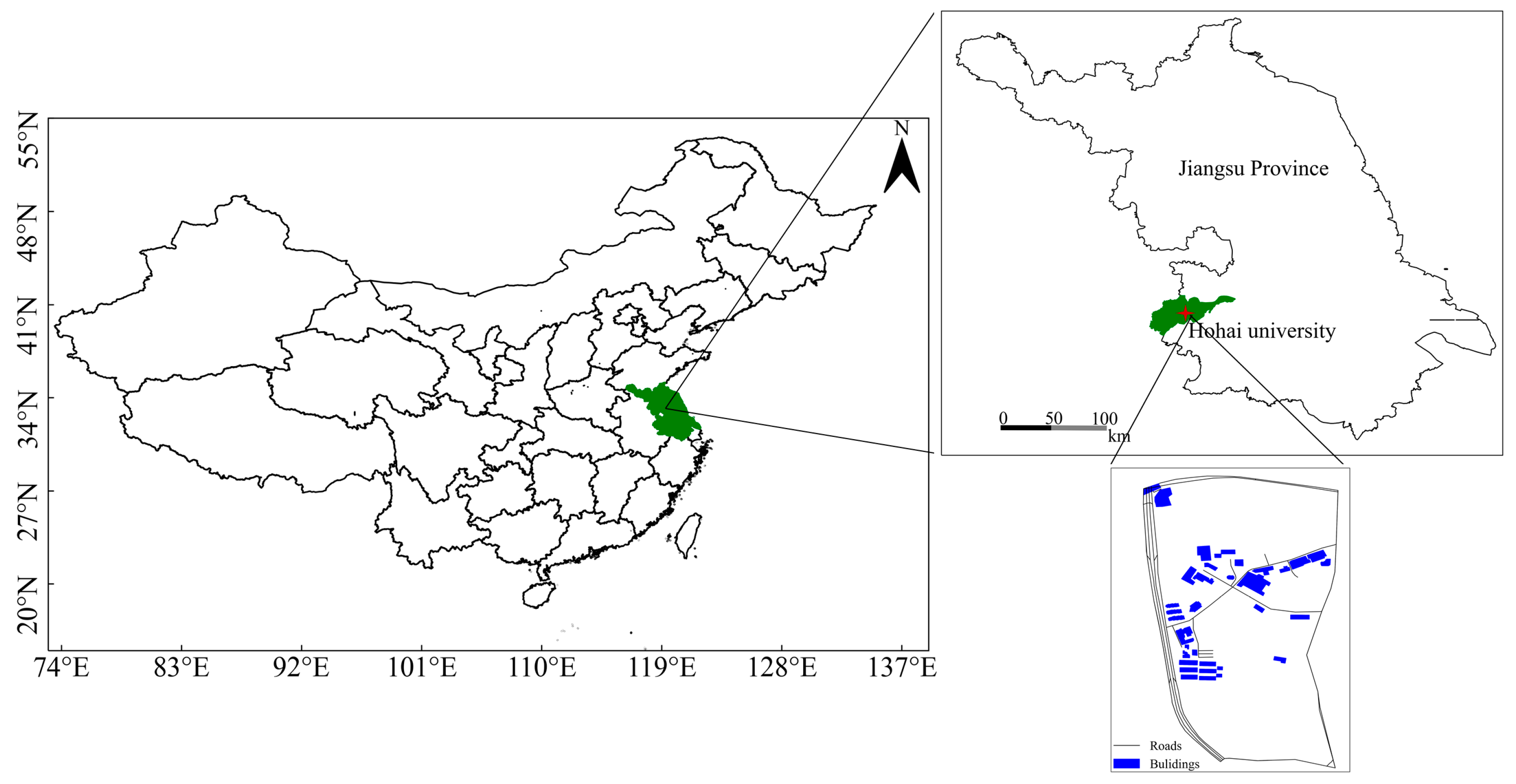
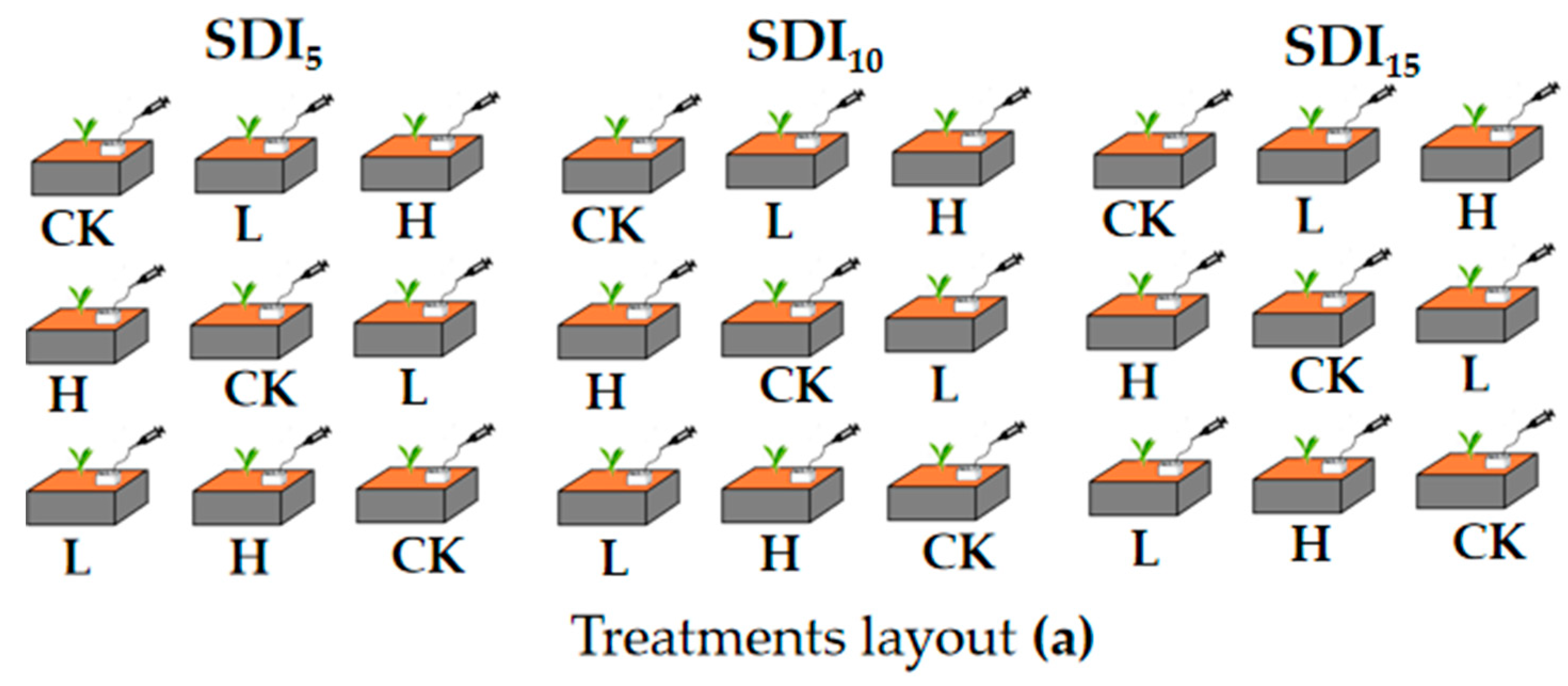
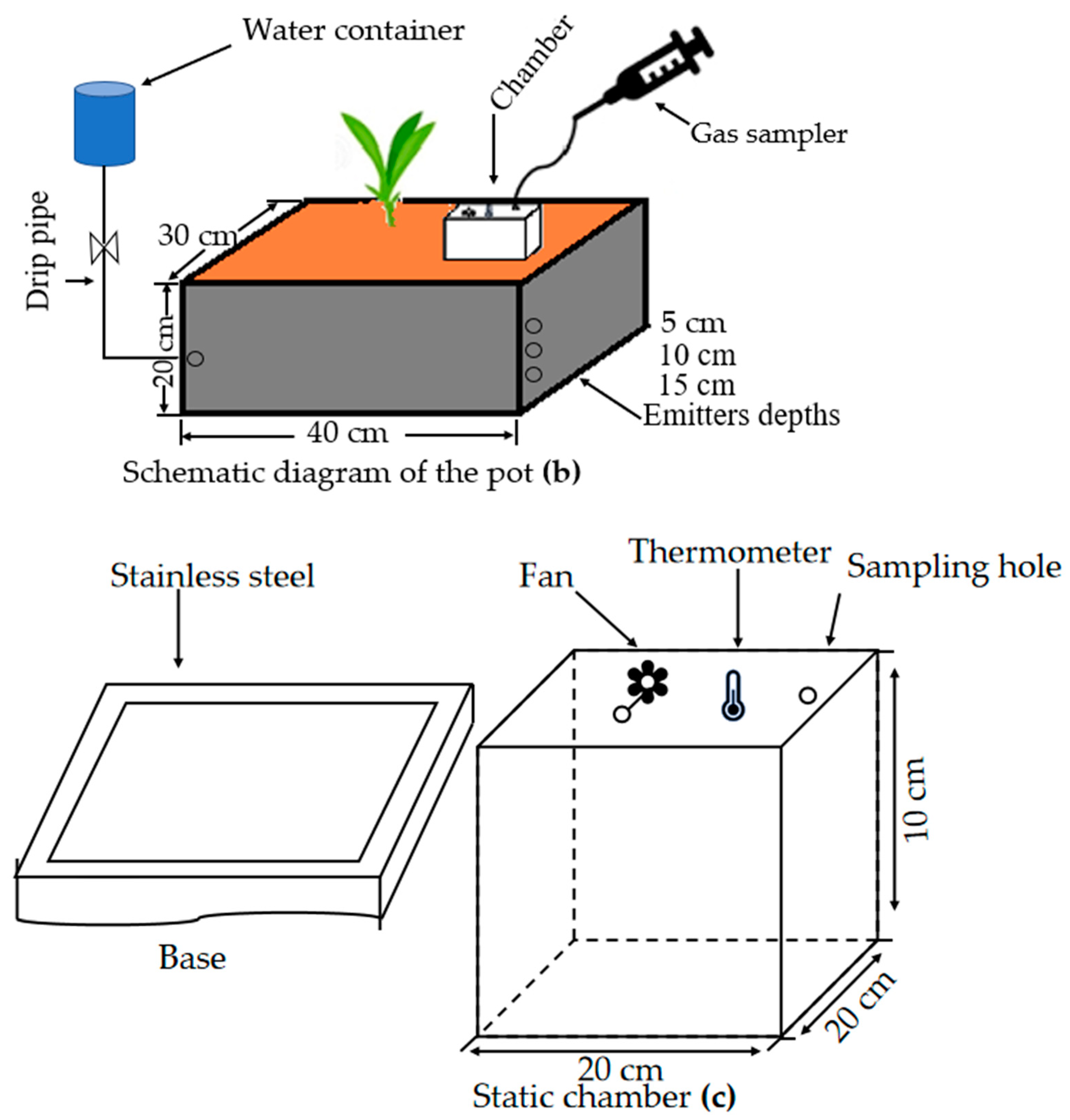
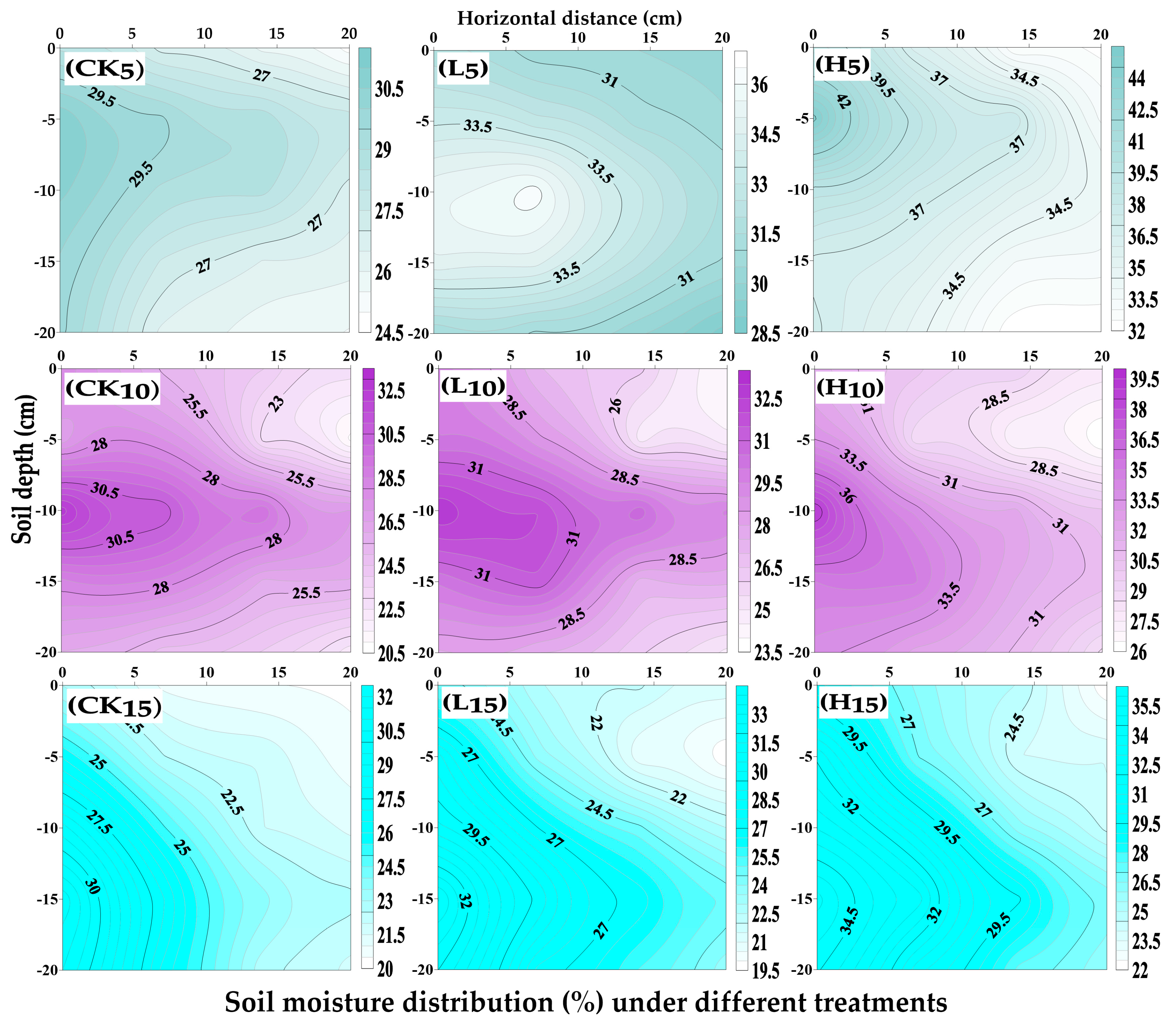
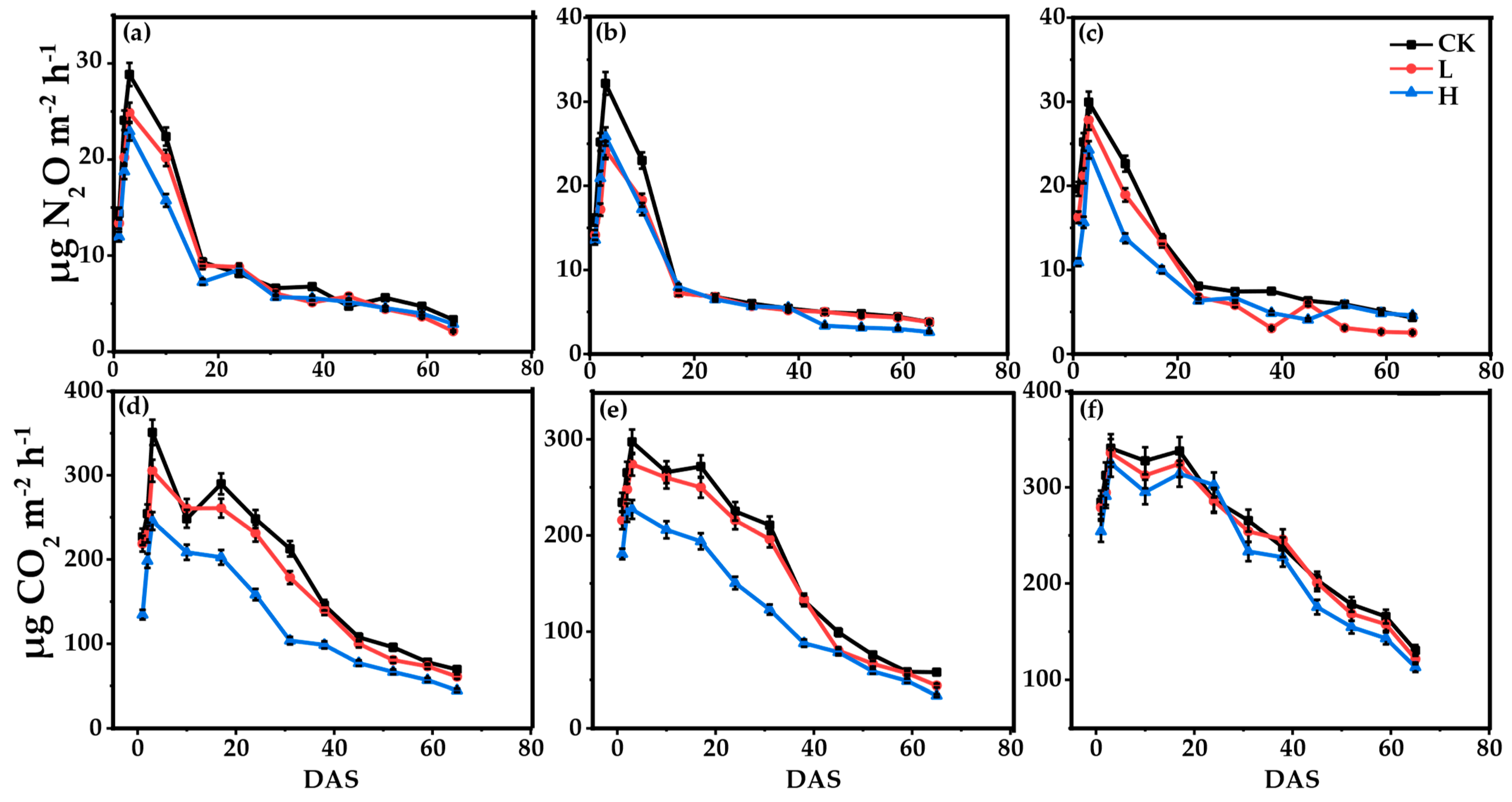
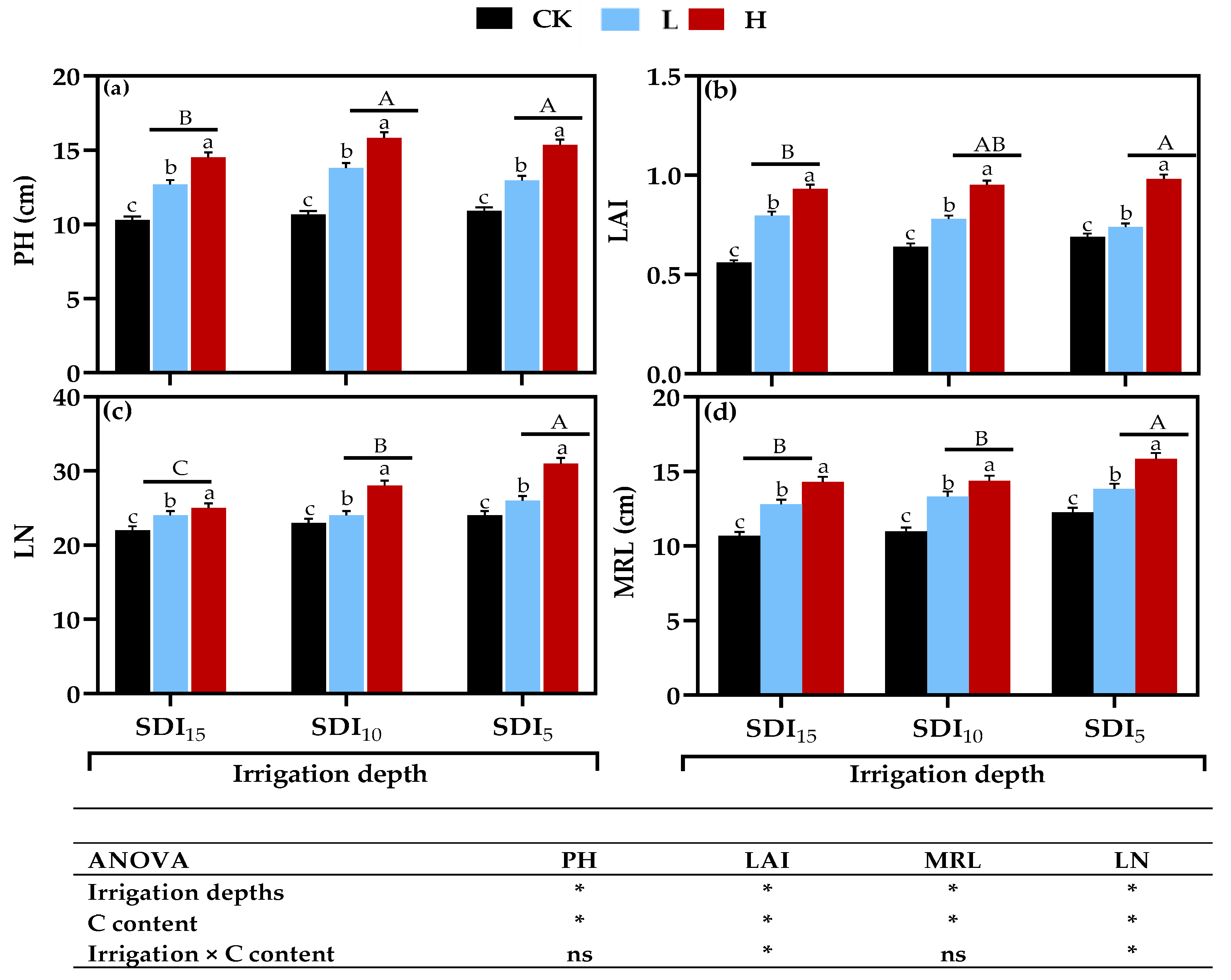
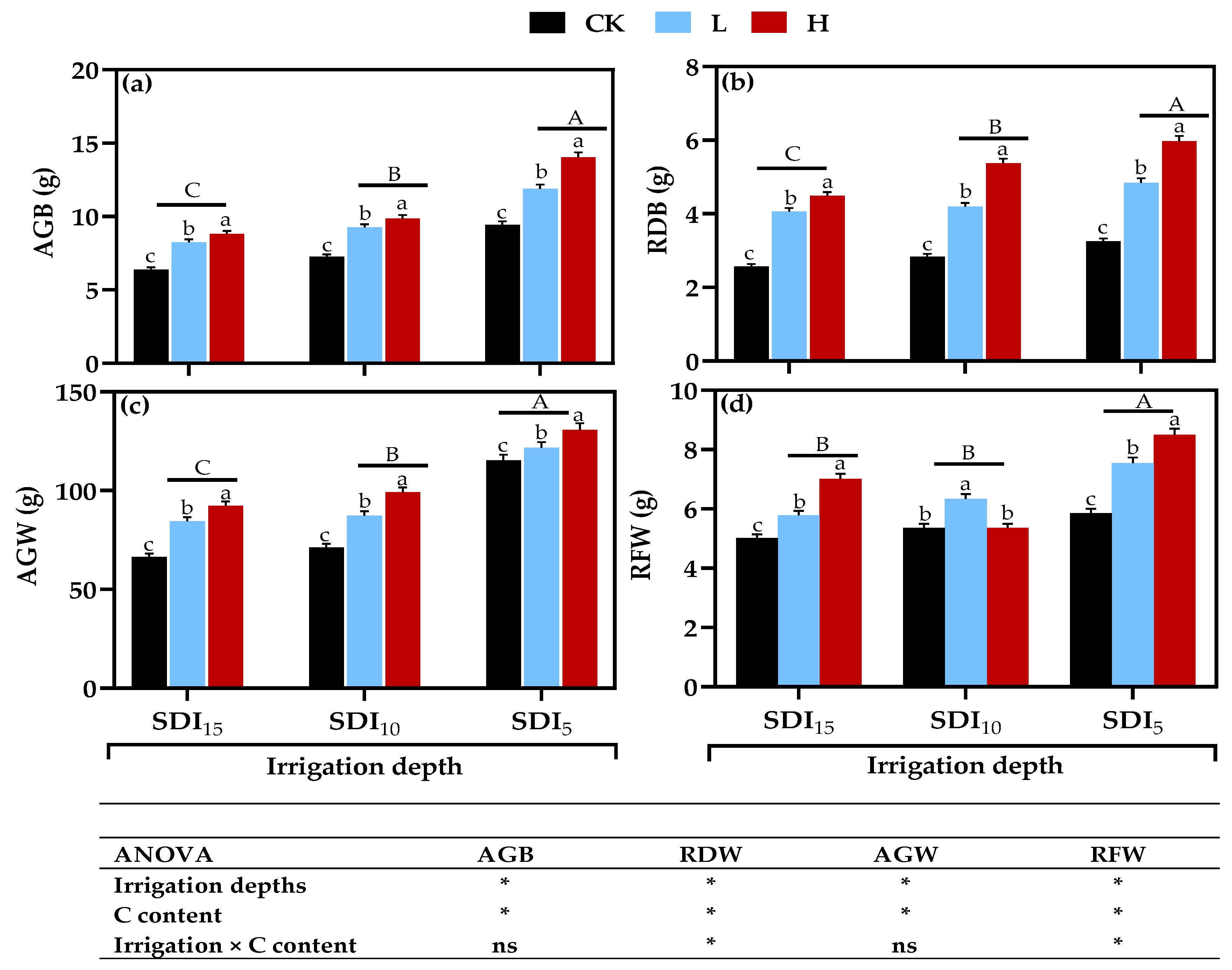
| Parameter | 2021 | |||||||||||
|---|---|---|---|---|---|---|---|---|---|---|---|---|
| January | February | March | April | May | June | July | August | September | October | November | December | |
| RH (%) | 75.19 | 78.62 | 78.5 | 74.81 | 75.31 | 76.94 | 86.00 | 85.62 | 82.88 | 80.25 | 75.38 | 71.75 |
| Max. T (°C) | 16.37 | 24.24 | 26.01 | 30.16 | 33.57 | 34.4 | 34.84 | 32.98 | 32.76 | 34.17 | 23.57 | 17.3 |
| Min. T (°C) | −9.86 | −3.88 | −2.46 | 3.93 | 11.37 | 16.00 | 22.31 | 20.4 | 15.9 | 5.9 | −2.38 | −5.59 |
| Max. W (m/s) | 6.86 | 8.68 | 7.29 | 9.28 | 7.80 | 8.02 | 8.00 | 4.78 | 6.49 | 8.13 | 9.00 | 7.89 |
| Min. W (m/s) | 0.14 | 0.25 | 0.22 | 0.24 | 0.22 | 0.09 | 0.12 | 0.09 | 0.06 | 0.33 | 0.09 | 0.35 |
| Property | Soil | Biochar |
|---|---|---|
| BD | 1.35 g cm−3 | - |
| Soil porosity | 0.33 g kg−1 | - |
| Silt | 34.68% | - |
| Clay | 43.59% | - |
| Sand | 20.61% | - |
| pH | 6.13 | 8.32 |
| TN | 1.32 g kg−1 | 1.27 |
| TP | 0.23 g kg−1 | 2.31 |
| EC | 0.38 ds m−1 | 0.08 |
| Irrigation Depth (m) | C Content in Biochar | Mean Soil Moisture Content (%) |
|---|---|---|
| CK | 27.77 ± 1.2 Ac | |
| SDI5 | L | 32.05 ± 1.3 Ab |
| H | 35.97 ± 1.5 Aa | |
| CK | 26.17 ± 1.1 Bc | |
| SDI10 | L | 28.16 ± 1.2 Bb |
| H | 31.39 ± 1.3 Ba | |
| CK | 24.02 ± 1.0 Cc | |
| SDI15 | L | 25.56 ± 1.1 Cb |
| H | 28.36 ± 1.2 Ca |
| Treatment | CK | L | H | |
|---|---|---|---|---|
| N2O (mg N2O m−2) | SDI5 | 7.82 ± 0.24 Ba | 7.18 ± 0.22 Bb | 6.13 ± 0.19 Bc |
| SDI10 | 8.74 ± 0.27 ABa | 8.74 ± 0.20 ABb | 6.30 ± 0.20 ABc | |
| SDI15 | 8.74 ± 0.27 Aa | 7.21 ± 0.23 Ab | 6.28 ± 0.20 Ac | |
| CO2 (mg CO2 m−2) | SDI5 | 147.23 ± 7.70 Ba | 137.69 ± 7.20 Ba | 101.82 ± 5.33 Bb |
| SDI10 | 141.38 ± 7.40 Ba | 133.24 ± 6.97 Ba | 100.07 ± 5.23 Bb | |
| SDI15 | 191.77 ± 10.03 Aa | 186.33 ± 9.75 Aa | 178.20 ±9.32 Ab |
Disclaimer/Publisher’s Note: The statements, opinions and data contained in all publications are solely those of the individual author(s) and contributor(s) and not of MDPI and/or the editor(s). MDPI and/or the editor(s) disclaim responsibility for any injury to people or property resulting from any ideas, methods, instructions or products referred to in the content. |
© 2023 by the authors. Licensee MDPI, Basel, Switzerland. This article is an open access article distributed under the terms and conditions of the Creative Commons Attribution (CC BY) license (https://creativecommons.org/licenses/by/4.0/).
Share and Cite
Hamad, A.A.A.; Ni, L.; Shaghaleh, H.; Elsadek, E.; Hamoud, Y.A. Effect of Carbon Content in Wheat Straw Biochar on N2O and CO2 Emissions and Pakchoi Productivity Under Different Soil Moisture Conditions. Sustainability 2023, 15, 5100. https://doi.org/10.3390/su15065100
Hamad AAA, Ni L, Shaghaleh H, Elsadek E, Hamoud YA. Effect of Carbon Content in Wheat Straw Biochar on N2O and CO2 Emissions and Pakchoi Productivity Under Different Soil Moisture Conditions. Sustainability. 2023; 15(6):5100. https://doi.org/10.3390/su15065100
Chicago/Turabian StyleHamad, Amar Ali Adam, Lixiao Ni, Hiba Shaghaleh, Elsayed Elsadek, and Yousef Alhaj Hamoud. 2023. "Effect of Carbon Content in Wheat Straw Biochar on N2O and CO2 Emissions and Pakchoi Productivity Under Different Soil Moisture Conditions" Sustainability 15, no. 6: 5100. https://doi.org/10.3390/su15065100
APA StyleHamad, A. A. A., Ni, L., Shaghaleh, H., Elsadek, E., & Hamoud, Y. A. (2023). Effect of Carbon Content in Wheat Straw Biochar on N2O and CO2 Emissions and Pakchoi Productivity Under Different Soil Moisture Conditions. Sustainability, 15(6), 5100. https://doi.org/10.3390/su15065100









